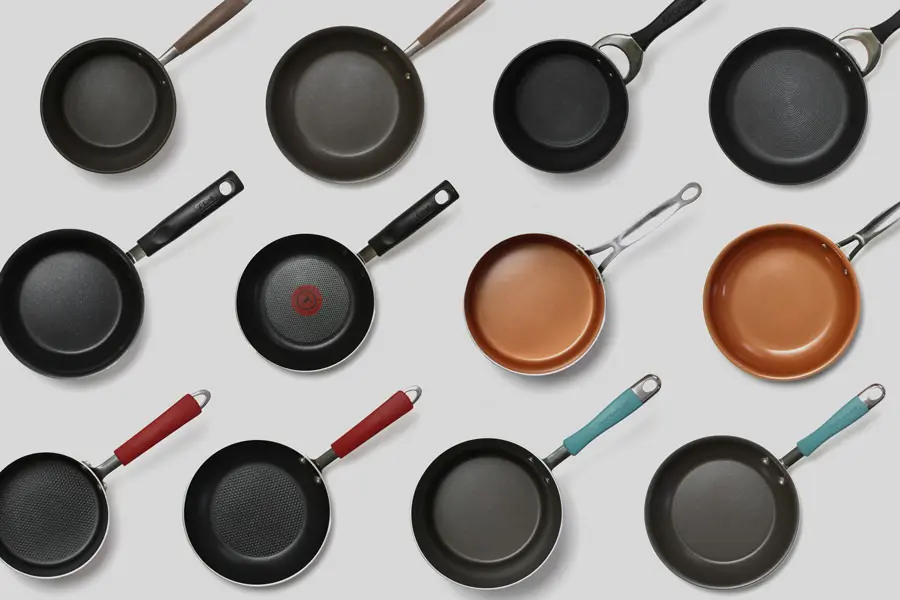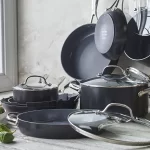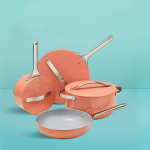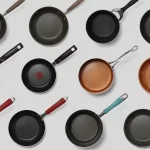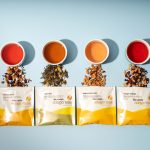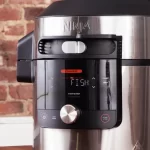Cooking is an art, and just like any other artist, a chef needs the right tools to create culinary masterpieces. Among these essential tools, cookware materials play a crucial role in determining the success of each dish. With a wide variety of options available today, it can be overwhelming for both professional chefs and home cooks to choose the best material for their cookware collection. That’s why this article aims to shed light on understanding the different types of cookware materials by weighing their pros and cons. Whether you are seeking durability, heat conductivity, or ease of maintenance, having comprehensive knowledge about various cookware materials will enable you to make informed decisions that enhance your cooking experience and elevate your gastronomic creations to new heights.
Stainless Steel: The Versatile and Durable Option
Stainless steel is a versatile and durable cookware material that offers many benefits.
- Versatility: Stainless steel pans can be used on all types of stove tops, including gas, electric, induction, and ceramic. This makes them suitable for any kitchen setup.
- Durability: Stainless steel is known for its strength and resistance to rust or corrosion. It can withstand high temperatures without warping or scratching, making it long-lasting.
Stainless steel also has other advantages when it comes to cooking:
- Heat distribution: Stainless steel distributes heat evenly across the surface of the pan, allowing for consistent cooking results.
- Non-reactive surface: Unlike some other materials like aluminum or copper, stainless steel does not react with acidic foods. This ensures that the flavor of your dishes remains intact.
- Ease of cleaning: Thanks to its non-stick properties, stainless steel requires minimal effort to clean. Most food residues can be easily removed with soap and water.
Whether you’re a professional chef or a home cook who loves experimenting in the kitchen, stainless steel cookware is an excellent choice due to its versatility and durability.
Nonstick Coating: The Convenient and Easy-to-Clean Choice
Nonstick coatings are a popular choice for cookware due to their convenience and easy clean-up. These coatings, typically made from materials like polytetrafluoroethylene (PTFE) or ceramic, prevent food from sticking to the surface of the cookware during cooking. This makes it easier to flip pancakes, sauté vegetables, or fry eggs without worrying about them getting stuck.
Advantages of Nonstick Coatings:
- Effortless Cleaning: Thanks to the nonstick coating, most food residues can be easily wiped off with a sponge or cloth.
- Less Oil Usage: As foods are less likely to stick, you can reduce the amount of oil needed for cooking.
- Even Heating: Nonstick surfaces distribute heat more evenly across the entire pan.
- Versatility: Nonstick coatings can be used on various types of cookware including frying pans, saucepans, and baking sheets.
While nonstick coatings offer many benefits in terms of convenience and ease-of-use in everyday cooking tasks; there are also some concerns that need to be addressed when using this type of cookware.
Disadvantages/Considerations for Nonstick Coatings:
- Limited Durability: Over time, the nonstick coating may wear off especially if not properly cared for or if metal utensils are used which could scratch or damage the surface.
- High Heat Limitation: Excessive heat beyond a certain temperature threshold can cause these coatings to release toxic fumes posing potential health risks. It is important to follow manufacturer instructions regarding maximum temperature limits.
- Scratching/Rivaled Performance with Metal Utensils: Using abrasive materials such as steel wool or metal utensils should be avoided as they may scratch or damage the non-stick coating leading its deterioration over time.
Ultimately, weighing both advantages and disadvantages will help individuals make an informed decision when considering nonstick cookware for their kitchen.
Cast Iron: The Classic and Long-Lasting Material
- Cast iron is a classic material that has stood the test of time in the world of cookware.
- It is known for its exceptional heat retention and even heating properties.
- This makes it ideal for searing, frying, baking, and slow-cooking dishes.
- Cast iron pans are versatile and can be used on the stovetop, in the oven, or even over an open fire.
- One of the biggest advantages of cast iron cookware is its durability. Properly cared for, it can last for generations.
- Although cast iron requires some maintenance to prevent rusting and retain its seasoning, many people find this upkeep worth it due to its superior cooking performance. Pros:
- Excellent heat retention and dispersal
- Durable; long-lasting if properly maintained
- Versatile; suitable for various cooking methods
- Heavyweight; difficult to handle
- Requires regular seasoning to maintain non-stick surface
Aluminum: The Lightweight and Affordable Alternative
Light as a Feather
Cooking enthusiasts appreciate aluminum cookware for its lightweight nature, making it easy to handle during meal preparation. Unlike its heavy cast iron counterparts, aluminum pots and pans are much easier to lift, stir, and maneuver without straining the wrists or arms. This lightweight characteristic is especially beneficial for individuals with limited upper body strength or those who enjoy whipping up culinary masterpieces on a daily basis.
Wallet-Friendly Purchase
In addition to being light as a feather, aluminum cookware is also known for its affordability. Compared to other materials like stainless steel or copper, which can be quite expensive due to their higher production costs, choosing an aluminum cooking set won’t break the bank. Whether you’re a budget-conscious home chef looking for durable kitchen essentials or someone starting out in their first apartment on a tight budget, investing in aluminum cookware allows you to save money while still enjoying high-quality performance.
- Lightweight nature makes it easy to handle
- Ideal choice for individuals with limited upper body strength
- Affordable option compared to materials like stainless steel or copper
Copper: The Superior Heat Conductor
Copper is renowned for its exceptional heat conductivity, making it a top choice among professional chefs.
- Its ability to distribute and transfer heat evenly ensures that food cooks uniformly, preventing hot spots or uneven cooking.
- By swiftly adjusting to changes in temperature, copper allows for precise control over the cooking process.
Additionally, copper pans have numerous advantages:
- Fast heating times: Due to its high thermal conductivity, copper cookware heats up quickly compared to other materials. This means less time spent waiting for your pan to reach the desired temperature.
- Energy efficiency: Copper’s excellent conductivity reduces energy consumption since it requires lower levels of heat input during cooking.
- Responsiveness: With copper’s rapid response time to adjustments in stovetop temperatures, you can easily fine-tune your culinary creations with precision.
Despite these benefits, there are certain drawbacks associated with using pure copper cookware that should be considered before purchasing:
a) High cost: Authentic copper cookware tends to be more expensive than other options due to the material’s quality and performance characteristics.
b) Reactivity issues: While non-reactive coatings or linings can mitigate this concern, bare copper may react negatively with acidic foods and alter their taste or appearance.
In conclusion, copper is an ideal choice if you prioritize superior heat conduction capabilities but bear in mind potential costs and reactivity concerns when deciding which type of cookware best suits your needs
Carbon Steel: The Professional Chef’s Secret Weapon
1. Superior Heat Conductivity
Carbon steel is renowned for its exceptional heat conductivity, allowing it to evenly distribute heat across the entire cooking surface. This ensures that food cooks more evenly and prevents hot spots or cold spots from forming.
2. Lightweight Yet Durable
Despite being lighter than cast iron, carbon steel cookware is incredibly durable and can withstand high temperatures without warping or buckling. Its strength makes it suitable for professional kitchens where heavy-duty usage is common.
3. Non-Stick Properties with Proper Seasoning
When seasoned properly, carbon steel develops a natural non-stick coating that improves over time with repeated use. This allows you to cook with less oil or fat while still preventing your food from sticking to the pan.
It’s crucial to remember that carbon steel requires regular maintenance by cleaning and seasoning after each use as it is prone to rust if not well cared for.
Ceramic: The Eco-Friendly and Chemical-Free Option
Ceramic cookware is an excellent choice for eco-conscious individuals as it offers several environmental benefits. Unlike non-stick coatings, ceramic does not contain harmful chemicals such as PFOA or PTFE that can be released into the air when heated. This makes it a safer option for both your health and the environment.
Additionally, ceramics are made from natural materials like clay and sand, which are abundant and renewable resources. The production of ceramic cookware uses less energy compared to other types of cookware materials like stainless steel or aluminum. By choosing ceramic, you can reduce your carbon footprint while still enjoying a durable and versatile cooking surface.
Here are some key reasons why ceramic cookware stands out among its competitors:
- Non-Toxic: Ceramic pans do not release toxic fumes when exposed to high heat.
- Easy to Clean: The smooth surface of ceramic allows for easy cleanup without the need for harsh chemical cleaners.
- Versatile Cooking Surface: Ceramic pans distribute heat evenly and retain heat well, making them suitable for various cooking methods.
- Long-Lasting Durability: With proper care, ceramic cookware can last for many years without losing its functionality.
Overall, choosing ceramic as your preferred cookware material provides a safe and sustainable option that minimizes exposure to harmful chemicals while ensuring exceptional cooking performance.
Glass: The Elegant and Oven-Safe Solution
- Glass cookware offers a sleek and elegant option for your kitchen.
- It is an excellent choice for oven cooking due to its high heat resistance.
- Glass can withstand temperatures up to 450 degrees Fahrenheit, making it suitable for baking dishes like casseroles and desserts.
- Its non-reactive surface ensures that flavors are not transferred between different ingredients during cooking, preserving the taste of your food.
- Cleaning glass cookware is simple as it is dishwasher safe and does not stain or retain odors.
However, there are some drawbacks to using glass cookware.
Pros:
- Sleek and elegant design
- Oven-safe up to 450 degrees Fahrenheit
- Non-reactive surface preserves food flavors
- Easy to clean in the dishwasher
Cons:
- Prone to shattering if exposed to extreme temperature changes suddenly
- Heavier than other materials, which may make handling difficult
- Not ideal for stovetop cooking as it heats slower than other materials
Despite these limitations, glass cookware remains a popular choice among home cooks who value its aesthetic appeal and reliable oven performance.
